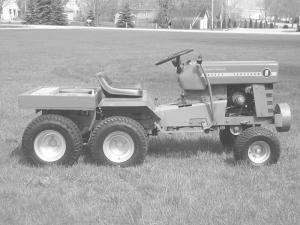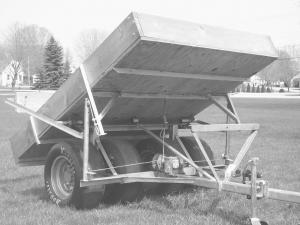2009 - Volume #33, Issue #1, Page #33
[ Sample Stories From This Issue | List of All Stories In This Issue | Print this story
| Read this issue]
Tandem Axle 4-WD Tractor, Trailer
 |
 |
"This rig lets us haul excess ground from graves dug in our local cemetery without damaging the turf," says Bruecker.
The dump trailer rides on four 12-in. wide stock car wheels aligned in a row, and is raised up or down by a heavy duty cordless drill which shaft-drives a transmission mounted on the trailer frame. The transmission has a 140 to 1 gearbox ratio, which makes it possible to dump a 4,000-lb. load in just 35 seconds.
"I came up with the idea because when graves are dug, there's always excess ground that has to be hauled away. A skid loader had been used, but it made too many deep wheel ruts," says Bruecker.
He bought another identical Massey Ferguson tractor and removed the rear end assembly, which he mounted behind the tractor's rear wheels. As a result the tractor now has two hydrostatic transmissions, which operate simultaneously using the tractor's original hydrostat control lever.
"It's amazing what this 8 hp tractor will pull. It has a lot of traction not only because it has 4-WD, but because it has two rear ends that are pulling together all the time," says Bruecker. "It'll pull a 4,000-lb. load of dirt with no problem.
"Hooking up the two transmissions was a simple job because there's a lever on the bottom of each transmission. I used one of the tie rods from the tractor that I cut up to link the levers together. They work simultaneously. The Massey tractor has a very rugged transmission."
He welded a frame onto the add-on rear end and attached it to the tractor. He also added a homemade 2-ft. sq. box on top of the rear end, which is used to carry tools, weights for traction, and a cushion for a rider. A home-built pivot allows the tandem axle wheels to go up or down on rough terrain.
The trailer is entirely home-built and hooks up to the tractor via a ball hitch. It has a 6 by 8-ft. box with 10-in. sides. There are two sets of wheels on each side, with a short axle mounted between each set of wheels.
Bruecker used 1/4-in. thick, 4-in. angle iron to build the trailer's frame. The hitch is made from 3-in. sq. tubing and has a bracket on it that supports a heavy duty drill. The drill shaft-drives a gearbox that has a spool mounted on back of it. A length of cable leads out from each side of the spool and goes up alongside a vertical pipe with a pulley on top of it, and then is connected to the box's frame.
A vertical length of cable is attached to the spool and is used to keep the box from "over centering" and dropping down too far as it goes up. "The vertical cable moves in the opposite direction as the horizontal cables, so when they're winding in it's winding out. It acts as a stop so the box can't go too far up," says Bruecker.
The trailer's endgate opens automatically as the box is dumped.
Contact: FARM SHOW Followup, Jerry Bruecker, 481 County Road CE., Kaukauna, Wis. 54130 (ph 920 766-2937; jbruecker@yahoo.com).

Click here to download page story appeared in.

Click here to read entire issue
To read the rest of this story, download this issue below or click here to register with your account number.




